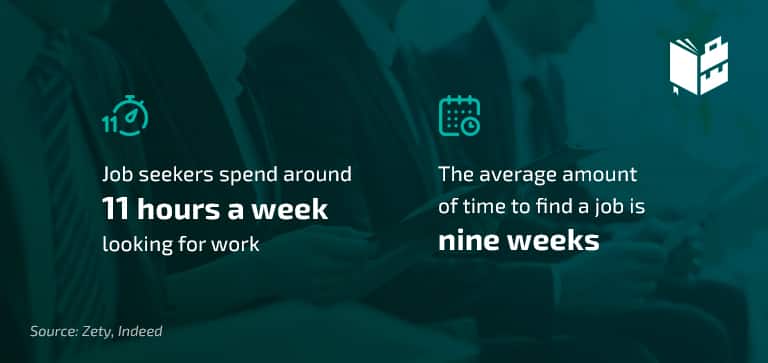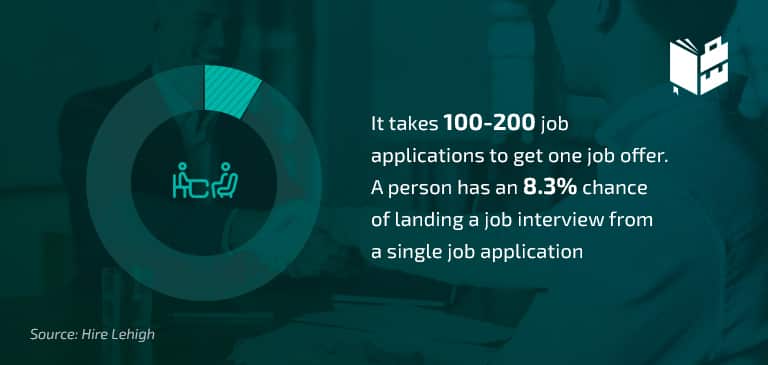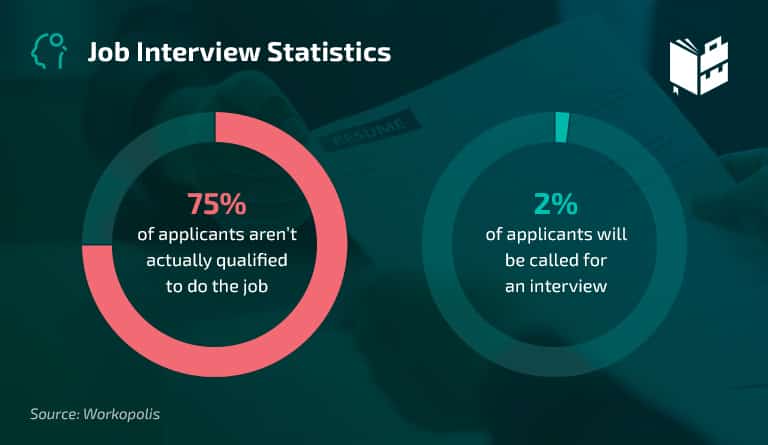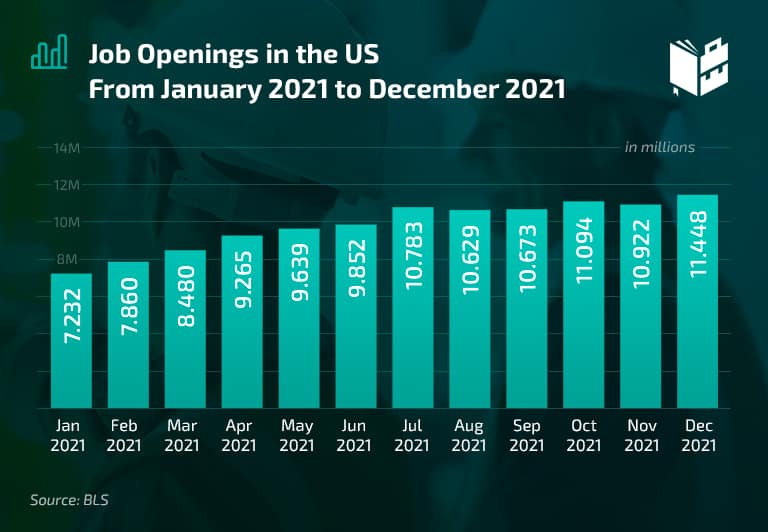Based on job searching statistics, hiring is going strong in spite of the huge impact COVID-19 has had on the world. Talent pools are expanding in quantity and quality as more individualwis seek higher education.
Still, finding the perfect job can be challenging. Whether you’re looking for your first job or want to make a career change, the following statistics will help you gain insight into the job market of today.
Interesting Job Search Statistics (Editor’s Choice)
- Each corporate job opening attracts about 250 resumes
- The average amount of time to find a job is nine weeks
- The ratio of unemployed individuals per job opening is now at 1.4, down from 5.0 in April 2020
- The number of job openings in the US reached 7.4 million in February 2021
- It takes 100–200 job applications to get one job offer
- The average time an employee spends working for one employer is 4.1 years
- 51% of job seekers say they prefer finding job opportunities on job search websites
- Job seekers spend around 11 hours a week looking for work
Job Searching Statistics
If you’re looking for a job, some statistics are worth considering before you start your journey, such as how much time you should invest in job searching daily, how long it takes to find a job, and where to look for job opportunities. Let’s see what you can expect.
1. Job seekers spend around 11 hours a week looking for work.
(Zety)
According to job search analysis, competition is a major factor that influences a person’s job search. As such, you might wonder if other candidates are putting in more effort and hours than you. Ultimately, there is no perfect amount of time to spend job searching. However, job seekers spend 11 hours per week on average looking for a job.
2. The average amount of time to find a job is nine weeks.
(Indeed)
The average length of a job search is nine weeks or about two months. Nevertheless, the time it takes to land a job is not the same for everyone. It mostly depends on personal accomplishments, level of education, experience in the field, and demand for a specific job position.

3. 51% of job seekers say they prefer finding job opportunities on job search websites.
(Glassdoor)
One of the job search facts is that job search websites have become the preferred and most popular way of searching for job opportunities. The reasoning behind this fact is that these specialized websites and mobile apps simplify job hunting by making it accessible and easier.
4. More women than men use mobile devices to apply for jobs.
(Go Hire)
When it comes to using a smartphone for job hunting, mobile recruiting statistics show that women use mobile devices and mobile apps to search and apply for jobs more than men. Furthermore, the most recent data show that out of the total number of candidates seeking new job opportunities and utilizing these job-hunting apps, 52% are female. On the other hand, women account for only 46% of desktop job seekers.
Resume Statistics
If you’re actively searching for a new job, creating an eye-catching resume is a must. Writing your resume requires a lot of thought and effort put into it as it will play a crucial role in landing a job you want.
5. Each corporate job opening attracts about 250 resumes.
(DevSkiller)
In a world where more and more people opt to pursue a college degree, competition is an ever-present factor when you’re looking for a job. According to job searching statistics, approximately 250 resumes are sent to recruiters and HR professionals per every corporate job opening.
6. It takes only around seven seconds for a recruiter to scan your resume.
(The Ladders)
Another reason why writing the perfect resume is crucial for finding a good job is that most recruiters take only seven seconds to make up their mind about a candidate, as HR statistics show. That means that you have only seven seconds to impress your recruiter and convince them that you’re the right person for the job.
7. 77% of HR professionals instantly reject a CV with grammar and spelling mistakes.
(The Motley Fool)
As discussed above, hiring managers don’t spend much time reading resumes. However, grammar mistakes are incredibly easy to spot. Therefore, 77% of hiring managers reject resumes immediately if they notice such mistakes. Make sure to proofread your resume first.
Job Application Statistics
Statistics on job applications are important to consider as well before starting your job hunting journey. These facts will help you understand what your chances of getting hired are and why you shouldn’t be disappointed if you get rejected.
8. It takes 100–200 job applications to get one job offer.
(Hire Lehigh)
A job seeker has to send between 100 and 200 job applications to receive a single job offer, as shown by competitive job market statistics. Also, according to Hirelehigh, a person has an 8.3% chance of landing a job interview from a single job application.

9. The ratio of unemployed individuals per job opening is now at 1.4, down from 5.0 in April 2020.
(Statista)
The global pandemic has affected employment worldwide. Fortunately, the US job market is showing signs of recovery. The number of job openings reached 7.4 million in February, which was the highest number since the pandemic started, as job search statistics show.
The unemployment rate dropped from 14.8% in April 2020 to 6% in March 2021. However, despite the increase in job openings, the number of unemployed people still exceeds the number of vacant job positions.
10. Four in five job seekers research a company’s online reviews and ratings when deciding whether to apply for a job.
(CMD Recruitment)
Reviews not only have the power to influence consumer decisions but can also help companies hire candidates. In the US, most job seekers are more likely to apply for a job at a company that has positive reviews.
Job Interview Statistics
After applying for a job, you’ll be invited for an interview if you get selected. The following facts are connected to the percentage of people who get offered an interview and things to look out for if you’re given the opportunity.
11. The average time from interview to a job offer is 20–40 days, depending on the industry and location.
(Zety)
According to job search stats, the amount of time from interview to getting a job offer varies, depending on the industry you’re targeting when you’re searching for a job and the skills you bring to the table. However, the average time is between 20 and 40 days.
12. Only 2% of applicants get an interview.
(Workopolis)
The internet has made searching and applying for jobs simple. However, based on US job statistics, applying for jobs you are not qualified for doesn’t increase your chances of getting hired. Stats show that 75% of applicants aren’t actually qualified to do the job, and only 2% of applicants will be called for an interview.

13. 41% of employers wouldn’t call a candidate back if they couldn’t find them on social media.
(ResumeLab)
When it comes to job interview stats and social media recruitment stats, 41% of employers say that they are less likely to call a candidate in for an interview if they can’t find them online. The reason behind it is that employers want to gather more information about the candidate before taking the next step in the recruiting process.
14. Recruiters assess a candidate’s soft skills through behavioral questions, situation questions, and body language.
(ResumeLab)
According to statistics on job searching, when a corporation is looking for a new employee, finding out more about that person is vital. Personality traits are as important as the skills necessary to do the job.
Such traits reveal a lot about a candidate, such as their problem-solving abilities, willingness to be a team player, communication skills, etc. Employers identify these things through behavioral questions, situation questions, and body language.
Employment Stats
The number of job openings available and the unemployment rate are also important things to consider when applying for jobs. As such, we made a list of statistics focusing solely on this topic.
15. The number of job openings in the US reached 11.45 million in December 2021.
(BLS)
At the end of December 2021, the Bureau of Labor Statistics revealed that there were nearly 11.45 million vacant positions in the US. If we consider the job-finding rate, the highest chance of landing a job was in health care and social assistance, accommodation and food services, entertainment, arts, and recreation because the number of job openings in these industries saw the largest increases.

16. The average time an employee spends working for one employer is 4.1 years.
(BLS)
Finding a job that suits your needs is another essential factor to keep in mind when searching for a new job. Based on research, the median number of years that wage and salary employees spend working for one employer is 4.1.
17. The percentage of jobs that use technology is at 82.
(Burning Glass Technologies)
Over the last couple of years, technology has become a major part of our everyday lives. As such, nothing is surprising about the fact that 82% of the total number of middle-skill jobs require some digital skills. Whether it’s using Microsoft Office or something more complicated, computer skills are indeed necessary to improve business operations.
Global Workforce Statistics
18. The coronavirus pandemic’s impact on jobs has been 10 times bigger than that of the global financial crisis.
(OECD)
The consequences of the pandemic are vast. Millions of people have been unable to work, resulting in a shocking drop in productivity and innumerable job losses. Unfortunately, the crisis will linger on, and the job market recovery is expected after the end of 2021.
As job search demographics show, many countries worldwide have witnessed the biggest economic crisis since the Great Depression that has severely impacted the job market. Furthermore, of all OECD countries, Italy was affected the most by the economic fallout of COVID-19 with the largest drop in hours worked.
19. The global pandemic has hit some counties harder than others.
(OECD)
Employers dealt with the pandemic in different ways. Some used retention programs to cut hours while allowing workers to keep their jobs and paychecks. Others chose not to hire new employees or make cuts. Spain, for example, is the only OECD country that recognizes coronavirus as an occupational disease.
20. The job crisis has affected young people and female employees the most.
(OECD)
According to hiring statistics, the pandemic has had a significant impact on young people and women in the workforce. The reason behind this statistic is that many women and young adults work in industries that have been affected the most by the global pandemic, such as travel and tourism, hospitality, retail, etc.
21. Automation and advanced technologies could make 73 million jobs in the US obsolete by 2030.
(Forbes)
Technology is indeed taking over jobs, as statistics show. Automation is nothing new, but it could be implemented faster in the future, especially due to COVID-19. Unfortunately, automation is projected to eliminate 73 million jobs by 2030 in the US. On a positive note, about 20 million workers could be given new but similar jobs.
Conclusion
Companies worldwide have switched to remote work out of necessity, and employers and employees are getting used to this dynamic. As stats show, many jobs are projected to remain remote. Furthermore, the job interview process has changed as it mostly relies on the phone and video calls.
If you are looking for a job, it’s vital to craft your resume carefully and tailor it for the applicant tracking system (ATS). Also, don’t be discouraged if you get rejected. Keep going and remember that perseverance is the key to success.